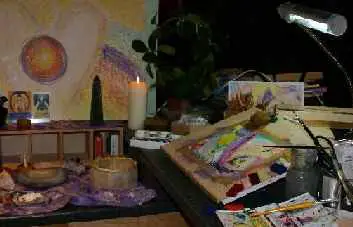ART THERAPY ACTIVITY "Drawing" Out Your Emotions
Art therapy activity
"The creative process involved in the making of art is healing and life enhancing".
- American Art Therapy Association Mission Statement
Art therapy activity...
This page will help you get started with your art therapy projects. We provide a supplies shopping list, make suggestions for creating a peaceful "healing place", and describe several projects to get you started. We suggest that you begin with an Art Journal or sketchbook as explained below.
As you begin to express your emotions through images, you will discover your inner voice-- the voice of your heart. Using art to express this voice will enable you to connect, maybe for the first time, with your deepest feelings and emotions. Expressing them through color, form, shape and texture releases their hold on you, clearing the way for healing to begin.
Another value of art as therapy: it gives you an enjoyable respite from your griefwork. And let go your critical inside voice that says things to you like: "Don't waste paint", or "You should be doing something else". Art making is a valuable and life enhancing activity. Allow yourself the freedom to explore and experiment and use as much material and time as you want. You may even be surprised at the results!
WHAT DO I NEED TO GET STARTED? 
Art therapy activity...
Where to get this stuff? Most of it can be found in the office supply section of WalMart or the Dollar Store. Some of the more specialized (and fun) tools must be bought at a craft place like Michael's, or an art supply store. Look for "art supplies" in the yellow pages.
Art therapy activity
Here's what you'll need to get started:
- All purpose sketch pad (11x14 or 14x17 to start with)
- Oil Pastels (Cray-Pas); Box of at least 12 colors
- Set of colored pencils
- Set of thin-line felt-tipped markers in several colors
- Artist' drawing pencils, soft lead like 2B or 4B, and sharpener
- Gum eraser and white eraser
- Crow Quill pen and bottle of black India ink
(tip: you must burn the tip of a new crow quill pen with a match or candle before the first use)

Now, where to set up a healing space where you can do your artwork? Try to find a quiet, private spot where you can work undisturbed or with few distractions. Make this place pleasant and restful. Light some candles or even incense. Bring in some of your favorite comfort items, photos, memorabilia, some cut flowers.
Look at your artwork sessions as classes or "lessons" where you are working to connect with your soul. Commit to one or two sessions per week, or even daily if you find you really enjoy and "get into" it.
Pop in a CD of some soothing music, soft instrumental, easy classical or "new age" would be best. Nature tapes are also nice; readily available at bookstores or even WalMart. No harsh, jarring music or songs with lyrics, as the words invade the creative "imagery" left-side areas of your brain.
OKAY, NOW WHAT? 

Art therapy activity...
There you are, all your shiny new art pencils sharpened and sketch pad open. How do you get started? There's two ways you can go with this:
- Unstructured, spontaneous creation. Just pick up a pencil, crow quill or pastels and start making a picture, or
- Start with a question or intention in your mind. Try this technique:
Art therapy activity
As you start each exercise, take a few moments for some "guided imagery". Get comfortable, put on some soft music, close your eyes and focus on what you are attempting to accomplish with this session. For example, if you are going to visualize "anger", attempt to see the colors and shape of that emotion in your mind's eye first.
Then open your eyes, choose the best medium, and get started. The images will come. You want to draw or paint an image of what your emotion looks like. And there is no right or wrong way to visualize it. Just work at it and trust your own way of coming to an image. It'll happen!
When you are done, take a good long look at your new creation. Do not analyze or criticize it, but do ponder it. What does it tell you? On the backside of the page, put the date and give your picture a title. Then write a few sentences from your heart about it.
No comments:
Post a Comment